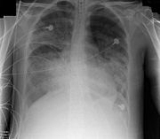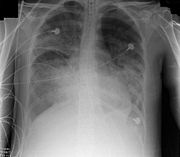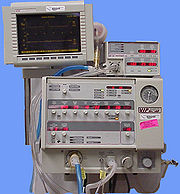
Respiratory failure
Encyclopedia
The term respiratory failure, in medicine
, is used to describe inadequate gas exchange
by the respiratory system
, with the result that arterial oxygen and/or carbon dioxide levels cannot be maintained within their normal ranges. A drop in blood oxygenation
is known as hypoxemia
; a rise in arterial carbon dioxide
levels is called hypercapnia
. The normal reference values are: oxygen Pa
O2
greater than 80 mmHg (10.7 kPa), and carbon dioxide PaCO2
less than 45 mmHg (6 kPa). Classification into type I or type II relates to the absence or presence of hypercarbia respectively.
without hypercarbia, and indeed the PaCO2 may be normal or low. It is typically caused by a ventilation/perfusion (V/Q) mismatch; the volume of air flowing in and out of the lungs is not matched with the flow of blood to the lungs. The basic defect in type 1 respiratory failure is failure of oxygenation characterized by:
|PaO2 || low (< 60 mmHg (8 kPa))
|-
| PaCO2 || normal or low
|-
| PA-aO2 || increased
|}
This type of respiratory failure is caused by conditions that affect oxygenation such as:
|PaO2 || decreased
|-
| PaCO2 || increased
|-
| PA-aO2 || normal
|-
|pH || decreased
|}
Type 2 respiratory failure is caused by increased airway resistance; both oxygen and carbon dioxide are affected. Defined as the build up of carbon dioxide levels (PaCO2) that has been generated by the body. The underlying causes include:

 Emergency treatment follows the principles of cardiopulmonary resuscitation
Emergency treatment follows the principles of cardiopulmonary resuscitation
. Treatment of the underlying cause is required. Endotracheal intubation and mechanical ventilation
may be required. Respiratory stimulant
s such as doxapram
may be used, and if the respiratory failure resulted from an overdose of sedative
drugs such as opioid
s or benzodiazepines, then the appropriate antidote
such as naloxone
or flumazenil
will be given.
Medicine
Medicine is the science and art of healing. It encompasses a variety of health care practices evolved to maintain and restore health by the prevention and treatment of illness....
, is used to describe inadequate gas exchange
Gas exchange
Gas exchange is a process in biology where gases contained in an organism and atmosphere transfer or exchange. In human gas-exchange, gases contained in the blood of human bodies exchange with gases contained in the atmosphere. Human gas-exchange occurs in the lungs...
by the respiratory system
Respiratory system
The respiratory system is the anatomical system of an organism that introduces respiratory gases to the interior and performs gas exchange. In humans and other mammals, the anatomical features of the respiratory system include airways, lungs, and the respiratory muscles...
, with the result that arterial oxygen and/or carbon dioxide levels cannot be maintained within their normal ranges. A drop in blood oxygenation
Oxygenation (medical)
Oxygenation occurs when oxygen molecules enter the tissues of the body. For example, blood is oxygenated in the lungs, where oxygen molecules travel from the air and into the blood...
is known as hypoxemia
Hypoxemia
Hypoxemia is generally defined as decreased partial pressure of oxygen in blood, sometimes specifically as less than or causing hemoglobin oxygen saturation of less than 90%.-Distinction from anemia and hypoxia:...
; a rise in arterial carbon dioxide
Carbon dioxide
Carbon dioxide is a naturally occurring chemical compound composed of two oxygen atoms covalently bonded to a single carbon atom...
levels is called hypercapnia
Hypercapnia
Hypercapnia or hypercapnea , also known as hypercarbia, is a condition where there is too much carbon dioxide in the blood...
. The normal reference values are: oxygen Pa
Partial pressure
In a mixture of ideal gases, each gas has a partial pressure which is the pressure which the gas would have if it alone occupied the volume. The total pressure of a gas mixture is the sum of the partial pressures of each individual gas in the mixture....
O2
Oxygen
Oxygen is the element with atomic number 8 and represented by the symbol O. Its name derives from the Greek roots ὀξύς and -γενής , because at the time of naming, it was mistakenly thought that all acids required oxygen in their composition...
greater than 80 mmHg (10.7 kPa), and carbon dioxide PaCO2
Carbon dioxide
Carbon dioxide is a naturally occurring chemical compound composed of two oxygen atoms covalently bonded to a single carbon atom...
less than 45 mmHg (6 kPa). Classification into type I or type II relates to the absence or presence of hypercarbia respectively.
Type 1
Type 1 respiratory failure is defined as hypoxiaHypoxia
Hypoxia may refer to:* Hypoxia , reduced dissolved oxygen content of a body of water detrimental to aerobic organisms* Hypoxia , a pathological condition in which the body as a whole or region of the body is deprived of adequate oxygen supply-Popular culture:* "Hypoxia" , a 2008 ambient song*...
without hypercarbia, and indeed the PaCO2 may be normal or low. It is typically caused by a ventilation/perfusion (V/Q) mismatch; the volume of air flowing in and out of the lungs is not matched with the flow of blood to the lungs. The basic defect in type 1 respiratory failure is failure of oxygenation characterized by:
-
-
- {| class="wikitable" border="1"
-
|PaO2 || low (< 60 mmHg (8 kPa))
|-
| PaCO2 || normal or low
|-
| PA-aO2 || increased
|}
This type of respiratory failure is caused by conditions that affect oxygenation such as:
- Parenchymal disease (V/Q mismatch)
- Diseases of vasculature and shunts: right-to-left shuntRight-to-left shuntA right-to-left shunt is a cardiac shunt which allows blood to flow from the right heart to the left heart. This terminology is used both for the abnormal state in humans and for normal physiological shunts in reptiles...
, pulmonary embolismPulmonary embolismPulmonary embolism is a blockage of the main artery of the lung or one of its branches by a substance that has travelled from elsewhere in the body through the bloodstream . Usually this is due to embolism of a thrombus from the deep veins in the legs, a process termed venous thromboembolism... - interstitial lung diseases: ARDSAcute respiratory distress syndromeAcute respiratory distress syndrome , also known as respiratory distress syndrome or adult respiratory distress syndrome is a serious reaction to various forms of injuries to the lung....
, pneumoniaPneumoniaPneumonia is an inflammatory condition of the lung—especially affecting the microscopic air sacs —associated with fever, chest symptoms, and a lack of air space on a chest X-ray. Pneumonia is typically caused by an infection but there are a number of other causes...
, emphysemaEmphysemaEmphysema is a long-term, progressive disease of the lungs that primarily causes shortness of breath. In people with emphysema, the tissues necessary to support the physical shape and function of the lungs are destroyed. It is included in a group of diseases called chronic obstructive pulmonary...
.
Type 2
The basic defect in type 2 respiratory failure is characterized by:-
-
- {| class="wikitable" border="1"
-
|PaO2 || decreased
|-
| PaCO2 || increased
|-
| PA-aO2 || normal
|-
|pH || decreased
|}
Type 2 respiratory failure is caused by increased airway resistance; both oxygen and carbon dioxide are affected. Defined as the build up of carbon dioxide levels (PaCO2) that has been generated by the body. The underlying causes include:
- Reduced breathing effort (in the fatigued patient)
- A decrease in the area of the lung available for gas exchange (such as in emphysemaEmphysemaEmphysema is a long-term, progressive disease of the lungs that primarily causes shortness of breath. In people with emphysema, the tissues necessary to support the physical shape and function of the lungs are destroyed. It is included in a group of diseases called chronic obstructive pulmonary...
). - Neuromuscular problems like, GB syndrome.
- Flail chest.
Causes

- Pulmonary dysfunction
- AsthmaAsthmaAsthma is the common chronic inflammatory disease of the airways characterized by variable and recurring symptoms, reversible airflow obstruction, and bronchospasm. Symptoms include wheezing, coughing, chest tightness, and shortness of breath...
- EmphysemaEmphysemaEmphysema is a long-term, progressive disease of the lungs that primarily causes shortness of breath. In people with emphysema, the tissues necessary to support the physical shape and function of the lungs are destroyed. It is included in a group of diseases called chronic obstructive pulmonary...
- Chronic Obstructive Pulmonary DiseaseChronic obstructive pulmonary diseaseChronic obstructive pulmonary disease , also known as chronic obstructive lung disease , chronic obstructive airway disease , chronic airflow limitation and chronic obstructive respiratory disease , is the co-occurrence of chronic bronchitis and emphysema, a pair of commonly co-existing diseases...
- PneumoniaPneumoniaPneumonia is an inflammatory condition of the lung—especially affecting the microscopic air sacs —associated with fever, chest symptoms, and a lack of air space on a chest X-ray. Pneumonia is typically caused by an infection but there are a number of other causes...
- PneumothoraxPneumothoraxPneumothorax is a collection of air or gas in the pleural cavity of the chest between the lung and the chest wall. It may occur spontaneously in people without chronic lung conditions as well as in those with lung disease , and many pneumothoraces occur after physical trauma to the chest, blast...
- Pulmonary contusionPulmonary contusionA pulmonary contusion is a contusion of the lung, caused by chest trauma. As a result of damage to capillaries, blood and other fluids accumulate in the lung tissue. The excess fluid interferes with gas exchange, potentially leading to inadequate oxygen levels...
- HemothoraxHemothoraxA hemothorax is a condition that results from blood accumulating in the pleural cavity.-Cause and presentation:Its cause is usually traumatic, from a blunt or penetrating injury to the thorax, resulting in a rupture of the serous membrane either lining the thorax or covering the lungs...
- Acute Respiratory Distress SyndromeAcute respiratory distress syndromeAcute respiratory distress syndrome , also known as respiratory distress syndrome or adult respiratory distress syndrome is a serious reaction to various forms of injuries to the lung....
(ARDS) is a specific and life-threatening type of respiratory failure. - Cystic FibrosisCystic fibrosisCystic fibrosis is a recessive genetic disease affecting most critically the lungs, and also the pancreas, liver, and intestine...
- Asthma
- Cardiac dysfunction
- Pulmonary edemaPulmonary edemaPulmonary edema , or oedema , is fluid accumulation in the air spaces and parenchyma of the lungs. It leads to impaired gas exchange and may cause respiratory failure...
- Cerebrovascular Accident
- Arrhythmia
- Congestive heart failureCongestive heart failureHeart failure often called congestive heart failure is generally defined as the inability of the heart to supply sufficient blood flow to meet the needs of the body. Heart failure can cause a number of symptoms including shortness of breath, leg swelling, and exercise intolerance. The condition...
- Valve pathology
- Pulmonary edema
- Other
- Fatigue due to prolonged tachypnoeaHyperventilationHyperventilation or overbreathing is the state of breathing faster or deeper than normal, causing excessive expulsion of circulating carbon dioxide. It can result from a psychological state such as a panic attack, from a physiological condition such as metabolic acidosis, can be brought about by...
in metabolic acidosisMetabolic acidosisIn medicine, metabolic acidosis is a condition that occurs when the body produces too much acid or when the kidneys are not removing enough acid from the body. If unchecked, metabolic acidosis leads to acidemia, i.e., blood pH is low due to increased production of hydrogen by the body or the... - Intoxication with drugs (e.g., morphineMorphineMorphine is a potent opiate analgesic medication and is considered to be the prototypical opioid. It was first isolated in 1804 by Friedrich Sertürner, first distributed by same in 1817, and first commercially sold by Merck in 1827, which at the time was a single small chemists' shop. It was more...
, benzodiazepineBenzodiazepineA benzodiazepine is a psychoactive drug whose core chemical structure is the fusion of a benzene ring and a diazepine ring...
s) that suppress respiration. - Neurological Disease
- Toxic Epidermal NecrolysisToxic epidermal necrolysisToxic epidermal necrolysis is a rare, life-threatening dermatological condition that is usually induced by a reaction to medications...
- Fatigue due to prolonged tachypnoea
Treatment

Cardiopulmonary resuscitation
Cardiopulmonary resuscitation is an emergency procedure which is performed in an effort to manually preserve intact brain function until further measures are taken to restore spontaneous blood circulation and breathing in a person in cardiac arrest. It is indicated in those who are unresponsive...
. Treatment of the underlying cause is required. Endotracheal intubation and mechanical ventilation
Mechanical ventilation
In medicine, mechanical ventilation is a method to mechanically assist or replace spontaneous breathing. This may involve a machine called a ventilator or the breathing may be assisted by a physician, respiratory therapist or other suitable person compressing a bag or set of bellows...
may be required. Respiratory stimulant
Respiratory stimulant
A respiratory stimulant is a drug which acts to increase the action of the respiratory system.An example is doxapram....
s such as doxapram
Doxapram
Doxapram hydrochloride is a respiratory stimulant. Administered intravenously, doxapram stimulates an increase in tidal volume, and respiratory rate.-Mode of action:...
may be used, and if the respiratory failure resulted from an overdose of sedative
Sedative
A sedative or tranquilizer is a substance that induces sedation by reducing irritability or excitement....
drugs such as opioid
Opioid
An opioid is a psychoactive chemical that works by binding to opioid receptors, which are found principally in the central and peripheral nervous system and the gastrointestinal tract...
s or benzodiazepines, then the appropriate antidote
Antidote
An antidote is a substance which can counteract a form of poisoning. The term ultimately derives from the Greek αντιδιδοναι antididonai, "given against"....
such as naloxone
Naloxone
Naloxone is an opioid antagonist drug developed by Sankyo in the 1960s. Naloxone is a drug used to counter the effects of opiate overdose, for example heroin or morphine overdose. Naloxone is specifically used to counteract life-threatening depression of the central nervous system and respiratory...
or flumazenil
Flumazenil
Flumazenil is a benzodiazepine antagonist available for injection only, and the only benzodiazepine receptor antagonist on the market today.It was first introduced in 1987 by Hoffmann-La Roche under the trade name Anexate, but only approved by...
will be given.

